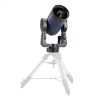Meade LX200-ACF 12 inch User Manual - Page 18
Focusing the Eyepiece Using the Microfocuser 16 Model, Slew Speeds
 |
View all Meade LX200-ACF 12 inch manuals
Add to My Manuals
Save this manual to your list of manuals |
Page 18 highlights
See MIRROR MIRROR, page 38, for more information about the microfocuser and the primary mirror lock. Tip: The slowest speed, 1x, may be changed using the Guiding Rate menu. This menu allows you to change the speed by entering a percentage of the speed (either more or less than 100%). This function may be useful in guiding the telescope during CCD and longexposure photography. See GUIDING RATE, page 30, for more information. - 18 - 9. Bring the object into focus (see below). Focusing the Eyepiece Using the Microfocuser (16" Model) The LX200-ACF zero image-shift microfocuser (Pg. 7 Fig. 1, 24) allows you to obtain the most precise image focus possible during visual, photographic, and CCD applications, maintaining precise and "jiggle-free" image centering on even the smallest CCD chips. To use the microfocuser: 1. Perform this part of the procedure during the daytime, without the eyepiece assembly (eyepiece, diagonal, etc.) attached to the microfocuser. Press the AutoStar II Focus button and then the Up and Down Arrow keys. Observe the microfocuser drawtube as it travels in and out. When the drawtube reaches the furthest extension of its travel, listen for a change in the pitch of the motor. Notice that the drawtube's maximum extension is about a half-inch out from the microfocuser. Set the drawtube so that it extends about a quarter-inch (about halfway). 2. When you begin your viewing session, attach the eyepiece assembly. See pages 13 and 14 for details. 3. Make sure that the microfocuser is plugged into the computer control panel focus port (Fig. 1, 13C). 4. Point the telescope at a bright star. 5. Rotate the mirror lock knob (Fig. 1 , 9) towards the "unlock" position, until it feels loose. Use the coarse focus control (Fig. 1 , 6) to achieve a rough focus of the star. 6. Rotate the mirror lock knob towards the "lock" position and adjust the tension to a firm feel; this action serves to lock in the coarse focus. Important Note: Do not use or bump the coarse focus knob once you have set the coarse focus. If you do so, repeat steps 5 and 6 above to reset the coarse focus. 7. Press the Focus key (Number key "4"). "Focus Control: Speed: Fast" displays. Press the Up or Down Scroll keys to cycle through the four speed options. Press ENTER to select the desired speed. Or press one of the following Number keys after pressing the Focus key to change the speed: Key # Speed Key # Speed 1 or 2 Fine 6 or 7 Medium 3, 4, or 5 Slow 8 or 9 Fastest 8. Use the Arrow keys to bring the star into fine focus. 9. You may need to repeat this procedure when you change eyepieces. Slew Speeds AutoStar II has nine slew speeds that move the optical tube at rates that are directly proportional to the sidereal rate and have been calculated to accomplish specific functions. Press the Speed key (Number key "1") and then press a Number key to change the slew speed, which is shown for about two seconds on AutoStar II's display. The nine available speeds are: Number Key 1 = Number Key 2 = Number Key 3 = Number Key 4 = Number Key 5 = Number Key 6 = Number Key 7 = Number Key 8 = Number Key 9 = 1x = 2x = 8x = 16x = 64x = 128x = 1.5° = 3° = Max = Guide Rate, programmable (see Tip at left) 2 x sidereal (0.5 arc-min/sec or 0.008°/sec) 8 x sidereal (2 arc-min/sec or 0.033°/sec) 16 x sidereal (4 arc-min/sec or 0.067°/sec) 64 x sidereal (16 arc-min/sec or 0.27°/sec) 30 arc-min/sec or 0.5°/sec 90 arc-min/sec or 1.5°/sec 180 arc-min/sec or 3°/sec 480 arc-min/sec or 8°/sec) Speeds 1, 2, or 3: Best used for fine centering of an object in the field of view of a higher power eyepiece, such as a 12mm or a 9mm eyepiece. Speeds 4, 5, or 6: Enable centering of an object in the field of a low-to-moderate power eyepiece, such as the standard Super Plössl 26mm. Speeds 7 or 8: Best used for rough centering of an object in the viewfinder. Speed 9: Moves the telescope quickly from one point in the sky to another.















